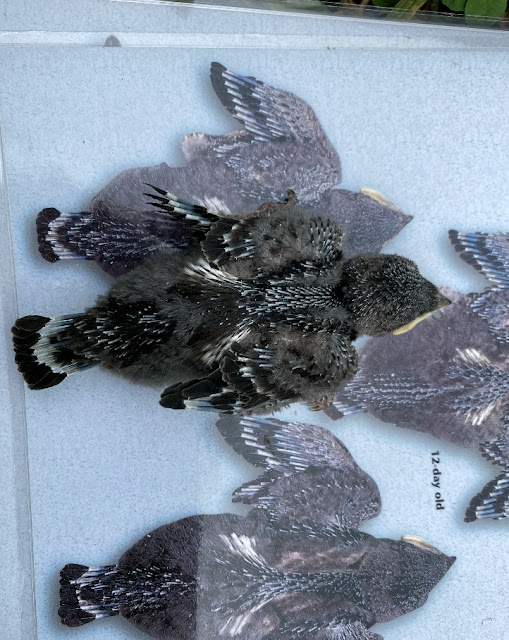By Beth Sullivan
Having been the grandmother to the
Purple Martins at Knox preserve for about seven years, I really look
forward to every season and have come to know the stages of
development that take place inside the secrecy of the nests. The
miracle is just too wonderful not to share.
 |
| The scouts stayed with their parents, properly distanced and masked. Photograph by Rick Newton. |
A little different this year
This year, with all the Covid
concerns, just two of us have been monitoring the nests, and we
haven’t been able to share the experience with anyone else. But
last Sunday, everything aligned just perfectly, and I was able to
introduce a new generation of Cub Scouts to the newest generation of
Purple Martins on the Knox Preserve. Pack 37 of Stonington, under
the leadership of Matt Ferrier, has helped out Avalonia on several
occasions. With extra muscle from parents, they planted seedling
trees on the Woodlot Sanctuary and have helped restore walls, make
brush piles and clean up in Hoffman Preserve. It was time for their
reward. With only a short notice to determine the weather would be
ok, and several families would be available, we set a time to meet.
Five Scouts, each with a parent or
two, and even a grandmother, arrived right on time. They spread out ,
properly distanced, and I was able to give them the first guidelines:
listen, stay distanced, and always keep your mask on as there would
be times when I would be close to them. We walked out the path to
the colony site, and the martins could be seen soaring against the
perfectly blue sky. We could watch them capture butterflies and
dragonflies and return to their nests to feed their young. I had
monitored them closely enough to know the age and stage of
development of the nestlings in each gourd, so after watching me
crank the winch to lower the set up, the boys could barely contain
their curiosity. One by one, with their own parent, they carefully
climbed the step ladder to be at the perfect height to peek into the
first nest. Last time I checked, there were still eggs; this time
there were three eggs, and one tiny pink nestling, just hatched. One
of the scouts actually found the eggshell on the ground. Everyone,
parents included, took a turn. Just amazing.
 |
| The first peek inside a nest. Photograph by Sandy Alexander |
 |
| The first nest was amazing. They got to see a brand new hatchling. |
 |
| Behind the mask they were grinning ear to ear. Photograph by Rick Newton. |
 |
| By comparing the live bird with the chart we could determine its age. |
A hands-on experience
Then we moved
to the next nest. Here the birds were about 9 days old. Using the
growth chart provided by the Purple Martin Conservation Association,
we were able to compare the live bird with the photos and look at
feather development on its wings and tail to determine its age.
Then, several of the scouts got to hold this bird. Ever so gently
they cupped the creature inside their hands. They could feel the
warmth, touch the stiff pin feathers and even see the holes in the
head that are the ears. Over their masks, their eyes just popped
with wonder. During the next half hour or so, others had a chance to
hold different birds, use the chart to compare, ask questions and beg
for more turns. They were hooked. As Scouts, they were ready and
willing to help, so as we finished the first set of gourds, they
stepped up to help me crank up the winch to raise the set high on the
pole.
There were even more birds of
various stages in the second set. More opportunities to peek inside.
And when we found a wonderful nest of 4 newborns on the upper level,
their parents helped lift them up to look. When the nest was
jostled, the birds would raise their heads and open their really huge
mouths, hoping for a morsel. Even with such large mouths, we were
all wondering how a parent could deliver the biggest dragonfly we
had ever seen, into one comparatively small mouth.
After they helped me crank up the
last set, we all sanitized our hands, and they had a Scout
mini-meeting in the field, still well distanced from each other.
Before they left the field, each turned to witness that the parent
birds returned very quickly, not at all disturbed by our activities,
to feed their hungry young ones.
With a few adjustments, this event
went on as it might have at any other time. The sun was shining, it
wasn't too hot, and the sky was a beautiful blue. The birds and
insects carried on as normal. It is so reassuring to know that some
things do not change.
 |
| The Scouts listened well to instructions and held the birds very gently. Photograph by Rick Newton. |
 |
| We wondered how the little birds could eat a dragonfly this size, even without its head. Photograph by Sandy Alexander. |
 |
| The parent birds waited patiently with their beaks full. Photograph by Rick Newton. |
Photographs by Beth Sullivan unless
otherwise indicated.

I loved reading this for so many reasons! Happy to see the young Scouts learning about nature - they will be the stewards, in the future. Thanks for all you do!
ReplyDelete